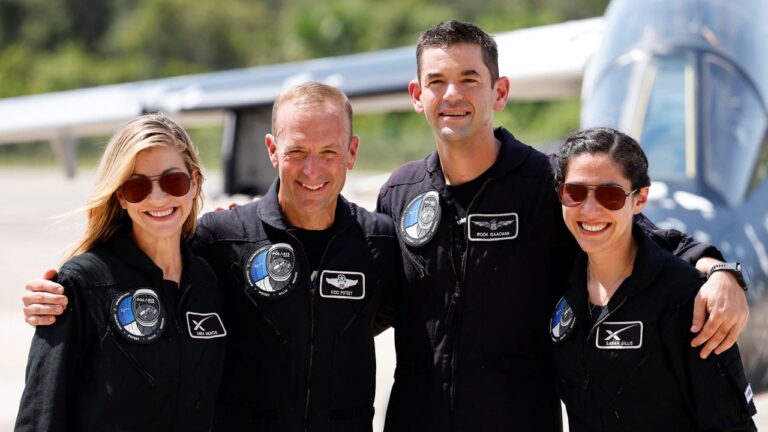- SpaceX astronauts will be the first non-government astronauts to attempt a spacewalk as part of the Polaris Dawn mission.
- The mission will also test SpaceX’s new slimline spacesuits and its Crew Dragon spacecraft, which has been modified so that the hatch door can be opened in the vacuum of space, eliminating the need for an airlock.
- SpaceX officials and the Polaris crew said at a press conference on Monday that they were planning for a variety of emergency scenarios in case something went wrong during the mission, such as an oxygen leak or a failure to reseal the hatch door, but did not elaborate on what those might be.
SpaceX’s first-ever private spacewalk attempt next week will be one of the most risky missions ever, testing pioneering equipment including a slimline spacesuit and an airlock-less cabin. Elon Musk’s space company.
The billionaire entrepreneur, a veteran fighter pilot and two SpaceX employees are scheduled to launch on Tuesday aboard a modified Crew Dragon spacecraft and then depart for a 20-minute spacewalk two days later, 434 miles into space.
Until now, walking into the empty space of space has only been attempted by government astronauts aboard the International Space Station (ISS), 250 miles above Earth.
SpaceX’s five-day mission, Polaris Dawn, will travel in an elliptical orbit, passing closest to Earth at 118 miles and furthest at 870 miles, the furthest humans have traveled since the end of the U.S. Apollo lunar missions in 1972.
The crew, including billionaire Jared Isaacman, will wear SpaceX’s new slimline spacesuits and fly in a Crew Dragon vehicle modified so that the hatch door can be opened in the vacuum of space — an unusual process that eliminates the need for an airlock.
“They’re pushing the limits in a lot of different ways,” former NASA astronaut Garrett Reisman said in an interview. “They’re also going to much higher altitudes and in more hostile radiation environments than we’ve seen since Apollo.”
Crew members of the privately-manned space mission Polaris Dawn, Anna Menon, Scott Poteet, Commander Jared Isaacman and Sarah Gillis, attend a press conference at the Kennedy Space Center in Cape Canaveral, Florida, on August 19, 2024. (Reuters/Joe Skipper)
The mission is being funded by Isaacman, founder of electronic payments company Shift4, who declined to disclose how much he spent, but it’s estimated to be more than $100 million.
Accompanying him will be retired U.S. Air Force Lt. Col. Scott Poteet, mission pilot, and SpaceX senior engineers Sarah Gillis and Anna Menon.
For SpaceX, which pioneered cheap, reusable rockets and expensive private spaceflight, the mission is a chance to advance technology that can be used on the Moon and Mars.
The electronics and shielding of Crew Dragon and its spacesuit will be tested as it passes through parts of the Van Allen belts, far outside the protective sphere of Earth’s atmosphere, where streaming charged particles, primarily from the Sun, can disrupt satellite electronics and affect human health.
“That’s an additional risk that you don’t face by just staying in low orbit and going up to the ISS,” Reisman said.
SpaceX’s new type of spacewalk
The Polaris spacewalk will take place on the mission’s third day, but preparations begin about 45 hours in advance.
The gumdrop-shaped Crew Dragon’s entire cabin will be depressurized and exposed to the vacuum of space, and while only two of the astronauts will be floating outside the craft on oxygen lines, everyone on board will rely on their space suits for life support.
A few days before the spacewalk, the crew begins a “prebreathing” process that fills the cabin with pure oxygen and removes nitrogen from the air.
The presence of nitrogen in an astronaut’s bloodstream while in space can form bubbles that restrict blood flow and cause a condition known as decompression sickness, like what happens when a scuba diver returns to the surface too quickly.
The crew will use an ultrasound device to monitor for bubble formation — one of many tools that will be used on the mission to inform dozens of science experiments, giving researchers a rare glimpse into how astronauts will spend their time on the lunar surface or elsewhere in deep space.
“This gives us a very unique opportunity to test these vehicles in a very unique environment,” said Emmanuel Urquieta, vice chair of aerospace medicine in the department of internal medicine at the University of Central Florida.
While astronaut safety on NASA missions is closely monitored by NASA, there are no similar U.S. standards or laws governing spaceflight safety on private missions such as Polaris.
Click here to get the FOX News app
SpaceX officials and the Polaris crew said at a press conference on Monday that they were planning for a variety of emergency scenarios in case something went wrong during the mission, such as an oxygen leak or a failure to reseal the hatch door, but did not elaborate on what those might be.
Reisman said he knows the Polaris crew well and believes they are prepared to handle any unforeseen incident.
“But there’s not much room for error,” he said.



